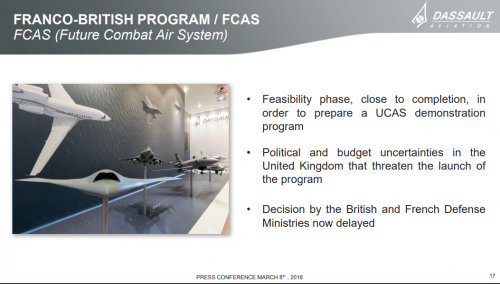Britain flip-flops toward ISR drone, but France keeps eye on combat capability
By: Pierre Tran May 11
The U.K. has expressed interest in an intelligence, surveillance and reconnaissance UAV over a combat-capable drone. (VanderWolf-Images/Getty Images)
PARIS ― An Anglo-French project for a combat drone demonstrator is switching tracks, as Britain is now more interested in pursuing a surveillance UAV, according to French Armed Forces Minister Florence Parly.
“The FCAS project is undergoing a reorientation,“ she said in an interview with weekly magazine Air & Cosmos, published May 11. “Our British allies would like to steer the project toward a surveillance drone.“
London and Paris, in a bid to pool their interest in respectively surveillance and combat drones, are working on “definition of the technology packages, which would allow us to feed into these two streams at the same time,“ she said.
France and the U.K. had planned to pursue a €2 billion (U.S. $2.4 billion) project to design and build a technology demonstrator for a combat drone, dubbed Future Combat Air System Demonstration Program, or FCAS DP. But the lack of announcement of a program launch at the Anglo-French summit in January was seen by French industry as a rethink on the British side.
France, however, has continued interest in building an unmanned combat air vehicle.
Despite the U.K.’s interest in an intelligence, surveillance and reconnaissance UAV, there was scope for cooperation with France by sharing the technology on the FCAS DP.
The technology packages were a “great opportunity“ that could be used in a broad project to integrate manned and unmanned aircraft into a combined network, dubbed Future System for Air Combat, Parly said.
Germany is the partner for France on the latter, which will be opened up to other European partners, she said. “Certain (countries) have already asked and nothing rules out opening the project up for the United Kingdom if they wish to join,“ she said.
Work on the FCAS DP project is “extremely useful“ for France and the U.K., she added. “This is not about public relations.“
Defense industry analyst Fabrice Wolf is not surprised at the revelation, as Britain will have the stealthy F-35 fighter jet for operations in high-intensity zones, and a UCAV would duplicate the F-35.
For France, and particularly Germany, it is “indispensable“ to have such a UCAV capability, he added. Germany needs a replacement for its Tornado fighter and a planned Franco-German fighter will enter service around 2040.
Time was needed to allow the FCAS DP projects to mature and then be considered for incorporation with a larger European program, Parly said.
The French approach, whether working on the project with Germany or the U.K., was to identify useful and concrete projects, work in close cooperation, build solid foundations, and then open up to other partners, she said, all aimed at building European defense.
A strengthening of ties between Berlin and Paris is seen by the French defense industry as partly due to London’s planned departure next year from the European Union.
Britain worked on its Taranis UCAV demonstrator, which was first flown by prime contractor BAE Systems in Australia in August 2013.
For France, the initial test program for its Neuron UCAV demonstrator began in December 2012 to September 2015, flying in France and partner nations Italy and Sweden. The six nations backing the program are France, Greece, Italy, Spain, Sweden and Switzerland, with the former acting as the lead nation.
Dassault Aviation is the Neuron prime contractor, with subcontractors Airbus Defence & Space of Spain, Alenia of Italy, Hellenic Aerospace Industry of Greece, Ruag of Switzerland, and Saab of Sweden.


![Our Farnborough Airshow stand.mp4_snapshot_02.03_[2018.08.22_23.42.16].jpg](/data/attachments/143/143691-f318848bd00ef6884c160f3e1e6e76f6.jpg)
![Our Farnborough Airshow stand.mp4_snapshot_02.02_[2018.08.22_23.42.08].jpg](/data/attachments/143/143690-0665911745c0d4f4e8dae92c59038696.jpg)
![Our Farnborough Airshow stand.mp4_snapshot_01.10_[2018.08.22_23.40.31].jpg](/data/attachments/143/143689-cb81ca90a7c4d83ff57e056a02037464.jpg)
![Our Farnborough Airshow stand.mp4_snapshot_01.09_[2018.08.22_23.40.22].jpg](/data/attachments/143/143688-dcab4f490573cfcd448590a589d09632.jpg)
![Taranis BAE's next gen combat aircraft.mp4_snapshot_01.26_[2018.08.22_23.18.37].jpg](/data/attachments/143/143687-cd51b2302ce276b10df2cabb5fb067c8.jpg)
![Taranis BAE's next gen combat aircraft.mp4_snapshot_01.22_[2018.08.22_23.18.24].jpg](/data/attachments/143/143686-aaff0489541ad0e572b586956516bc28.jpg)
![Taranis BAE's next gen combat aircraft.mp4_snapshot_00.24_[2018.08.22_23.17.04].jpg](/data/attachments/143/143685-282b456e67d456f16fe1c62192d5fbe3.jpg)
![Taranis BAE's next gen combat aircraft.mp4_snapshot_00.19_[2018.08.22_23.16.16].jpg](/data/attachments/143/143684-6e6d692a6436a59efcc85e57087d0f57.jpg)




